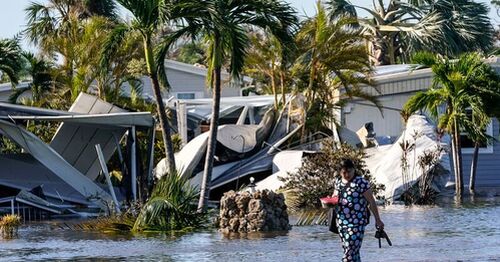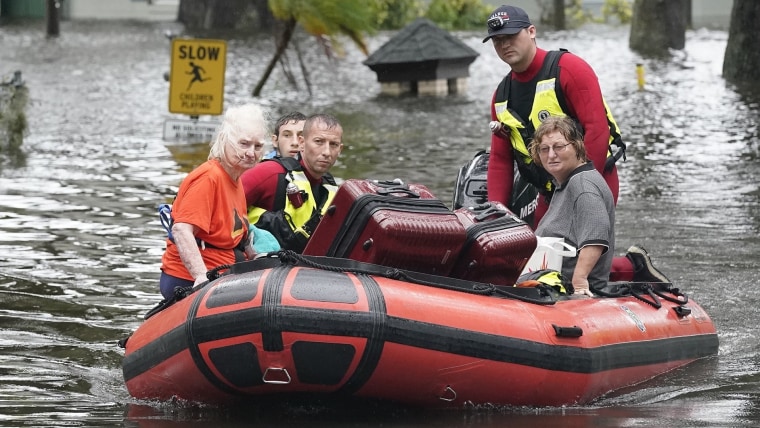
How high prices could impact rebuilding cost after Hurricane Ian
If there's any consolation for survivors of Hurricane Ian, it's that the rising cost of building materials has started to slow — and in some cases even reversed.
Thanks to a global economic slowdown, what seemed like a relentless increase in prices for materials over the past year or two had started to fade by the time Ian struck southwest Florida on Wednesday as a Category 4 storm.
The price of lumber, which surged during the Covid-19 pandemic and peaked in January, has returned to pre-pandemic levels, data from CME Group, a global markets company, show. It’s due in part to a sharp slowdown in construction as higher mortgage rates and higher home prices have taken hold.
Meanwhile, global shipping bottlenecks have eased, making more shipping containers available and reducing the cost of freight. Data from Drewry’s index, a global shipping tracking firm, show costs fell for 31 consecutive weeks, and have declined by 61% over the past 12 months.
"You're not going to have to spend so much on flooring or kitchen supplies — right now [prices] are going down as we speak," said Michelangelo Cocchiola, co-owner of Imeca Lumber & Hardware in Florida. "If the hurricane had hit two months or three months earlier, it would have been so much worse than now."
Nationwide demand for houses has ground to a halt, said Brendan Lowney, principal of Forest Economic Advisors, a company that studies building costs. The run-up in prices has also caused producers of key commodities like lumber to expand production capacity, helping to cool off those price gains, Lowney said.
In addition to lumber, prices for other key homebuilding commodities like PVC (polyvinyl chloride) and copper are also reversing, according to market data.
The cost of materials "have come down substantially," Lowney said.
But they are still elevated. The Bureau of Labor Statistics reported this month that prices for building materials had climbed 4.9% through the year-to-date, and were up 14.3% over the past year.
Power outages complicate Hurricane Ian rescue efforts in Florida
Oct. 1, 202202:51The sheer scale of the rebuilding to be done could also cause demand and prices to increase from here. According to the property information group CoreLogic, early estimates suggest Hurricane Ian will prove the costliest Florida storm since Hurricane Andrew hit the state in 1992, with a record number of homes and properties lost.
"Hurricane Ian will forever change the real estate industry and city infrastructure," said Tom Larsen, CoreLogic's associate vice president overseeing hazard and risk management. "Insurers will go into bankruptcy, homeowners will be forced into delinquency and insurance will become less accessible in regions like Florida."
Hurricane Ian victims and disaster responders are likely to encounter other rising costs amid an annual headline inflation rate that continues to hover above 8%.
Food price increases continue to hit multi-decade highs. Stephanie Ink-Edwards, CEO of Community Cooperative, an organization that fights hunger and homelessness in Lee County, said among the losses Ian victims are encountering is an absence of perishable food. She said food costs were already triple what they were last year in certain instances, even before the storm hit.
"The outflow of people in need who we must serve is now so much higher, but the cost to get supplies is also higher, so we're feeling the pinch from both ends," she said.
And while gas prices have come down from their summer peaks, with a Florida gas-tax holiday set to kick in Oct. 1, they remain well above their year-ago levels. As of Friday, the average price of regular unleaded gasoline in Florida was $3.39, according to AAA. That's about $0.33 higher than it was last September.
This week, Costco executives warned that they were seeing higher wages among suppliers — costs that will ultimately be passed on to consumers, in some cases.
"Wages are still the culprit,” said CFO Richard Galanti, adding: "We'll try to unstick them, but I’m sure some of it will stick and some of it won't."
It is also likely to be harder — and costlier — to find qualified labor to help in the rebuilding process, experts say. While the global economic slowdown may be easing the cost of materials, Florida remains in the midst of a building boom, said Rusty Payton, CEO of the Florida Homebuilders Association.
"They've already got plenty of projects to get done," Payton said. "You're not going see a mass migration of folks" to southwest Florida.
Lowney predicted labor costs may jump in the short term as building contractors ration their services.
"In other words, they will raise their rates as high as the market will bear," he said.
On the flip side, with demand for jobs in Florida at an all-time high, those who have been displaced from their occupations by the storm are likely to find work more quickly than in other post-disaster periods, Lowney said.
"It's going to be less stressful if people don’t have to worry about being unemployed," Lowney said.
At least one local state official estimated Thursday it would take a decade to rebuild the areas hit hardest by the storm.







